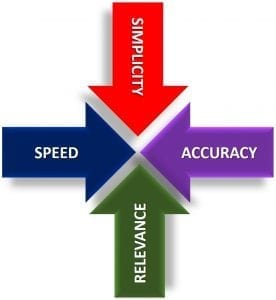Parts 3 and 4 of this series introduced the issue of test method selection. Starting with Part 7, I’ll spend the next few posts drilling down into different testing options when you want to evaluate fuel system microbiological contamination.
Today let’s start with two questions. These are the two questions that should drive most predictive maintenance test decisions:
→What do I need to know to be sure I have a microbial contamination problem?
→What will I do with test results?
Although microbiology data are useful – even important – they are only part of the story. This means that the first question’s answer is not necessarily microbiology data. In this blog post, I’ll focus on the first question.
What do I need to know to be sure I have a microbial contamination problem?
There’s an old joke in which one person asks another: “Why do you always answer my questions with a question?”. The person to whom the question was posed responds: “Do I?” In the same vein, the answer to What do I need to know? is What will you do with the results? There is no benefit to running any test if the results do not drive some action when the results indicate that conditions are not normal (i.e.: in specification). This means that when a technician is tasked with running a test, they need to know three things:
• How to run the test
• What the test results indicate
• The next action to be taken if the results indicate that conditions are not normal.
Running tests – every test method should be detailed in a standard operating procedure (SOP) document. This SOP can be an ASTM, PEI or other method developed as a consensus standard. It can be a method developed by an employer. As I noted in Part 5, the Navy uses Maintenance Requirement Cards (MRC). A well written SOP lists all materials, supplies and tools needed to perform the task. It lists both hazards and potential interferences. It then provides detailed instructions for how to complete the task. Next, test method SOP specify what to report and how to report the results plus supporting information. Finally, the test method SOP provides guidance on how to interpret the results and what action to take.
What the results indicate – some methods generate numerical data. For example, one of the easiest tests to run is dispenser flow-rate. The technician either determines how long it takes to dispense a specified volume of fuel, or determines how much fuel is dispensed during a fixed time. The results are reported as gallons (or liters) per minute (gpm). Without some context, the results are not particularly helpful. However, we can assign attribute scores to flow-rate ranges; for example:
• 8 gpm ((30 l/min) to 10 gpm (38 l/min): normal;
• 6 (23 l/min) gpm to <8 gpm: moderately reduced; and
•<6 gpm: severely reduced. For fleet operations, the breakpoints might be 36 gpm (136 l/min) and 24 gpm (91 l/min).
Having assigned attribute scores to our raw data, we know that the flow-rate of a retail dispenser dispensing fuel at 4 gpm (15 l/min) is severely reduced. Some action is needed.
What action is needed? – most often – particularly for quick and dirty tests – the action triggered by a test result that indicates that there is a problem, is additional testing. In our dispenser flow-rate example, the severely reduced flow can be a symptom of different causes; including microbiological contamination.
For example, if the test is run when several dispensers are being operated, the pump might not have sufficient power to deliver full flow to all active dispensers. An under-capacity pump has nothing to do with microbiological contamination. Alternatively, reduced flow could be a symptom of contamination. Again, not all contamination is microbial. Moreover, the assumption that slow-flow is due to filter plugging can be wrong. This leads to a set of IF/THEN instructions:
• IF flow <6 gpm, THEN retest after confirming that no other dispensers are operating.
• IF flow <6 gpm when no other dispensers are operating, THEN replace filter and retest flow rate.
• IF flow is <8 gpm after replacing filter; THEN clean dispenser prefilter (screen) and retest flow rate.
• IF flow rate is <8 gpm after cleaning prefilter; THEN test leak detector, replace if necessary, and retest flow rate.
• IF flow rate <8 gpm after testing/replacing leak detector; THEN test/repair/replace submerged turbine pump and retest flow rate.
Notice that in each case, the level of effort is greater and the flow rate is retested after the action has been completed.
By now, perhaps you are wondering: All this is interesting but what do I really need to know to be sure I have a microbial contamination problem? Stay tuned. In Part 8, I’ll offer some approaches to how you can answer that question.
Flow-rate testing as I’ve described here is one example of tiered testing. Here I reran the same test after taking increasingly complex maintenance actions. In future posts, I’ll write about more tiered testing in which the results from a simple test trigger the need to run a more complex test. I’ll also discuss individual test methods and share my opinions about their respective advantages and limitations. If you are impatient and want to learn more now, contact me at fredp@biodeterioraiton-control.com.


